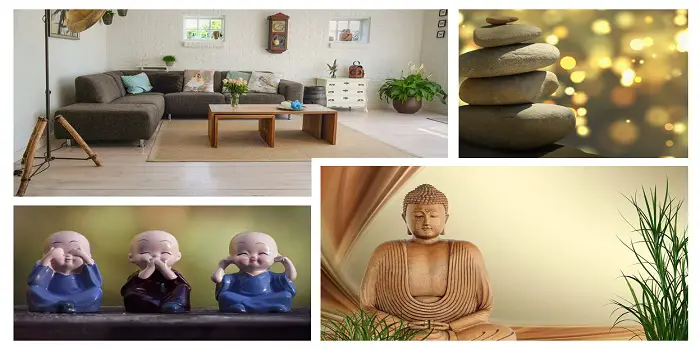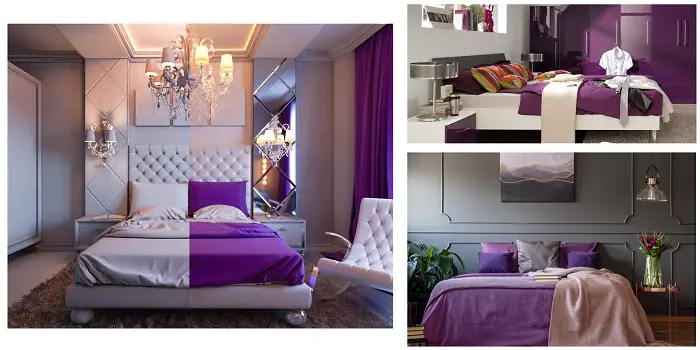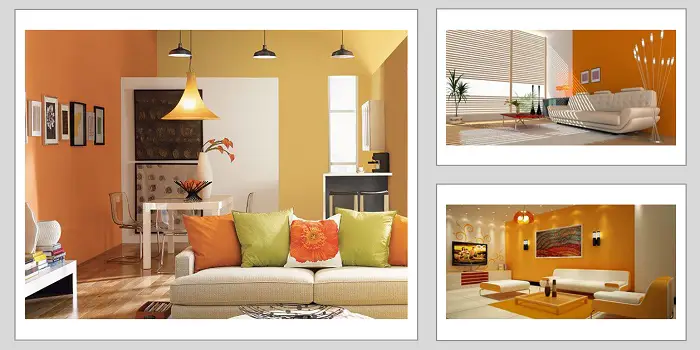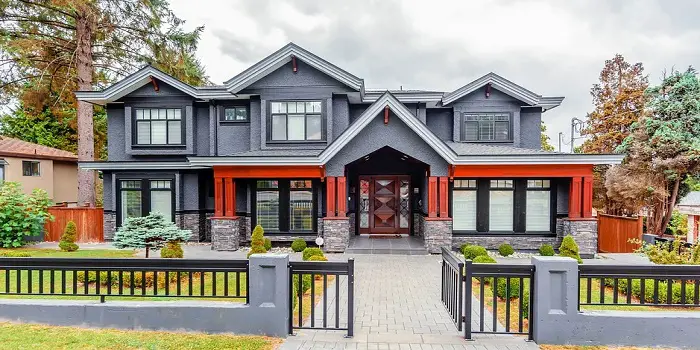
You can’t go wrong with a basic neutral when selecting a color for your house exterior.
However, if you want to stand out from the endless rows of houses with white color, think of giving your facade a dark makeover with grey paint.
Gray has found its way outside in recent years, and it turns out that a coat of the color looks just as good on the siding of wood color as on the walls of the living room.
Gray paint can emanate elegance or make a dramatic statement depending on how warm you go.
Gray also looks great on several types of houses, like the Shingle Style, which has historically featured the color.
If you aren’t ready to go grey, consider putting grey paint on trims, doors, windows, shutters, etc… to give contrast without overpowering your main hue, as grey can also be a wonderful accent color.
What's Here in the Article:
Popular Gray Exterior Paint Colors for Your House
Not sure which warm shade to pick from the many shades of gray?
Here are some of the warmest grays for your home exterior…
1. Benjamin Moore Classic Gray
A timeless neutral gray for house exteriors, Benjamin Moore Classic Gray is that elegant guest who fits in at every party—refined, warm, and effortlessly adaptable.
It leans toward greige, gracefully shifting with daylight—appearing like a soft gray exterior paint color in bright sunlight and a warm beige-gray under shade.
Perfect for homeowners who want understated sophistication rather than statement drama, this medium gray exterior house color flatters traditional and modern façades alike.
Pair it with crisp white trims or black shutters for a balanced, timeless appeal that feels both calm and inviting.
2. Sherwin-Williams Gray Screen
Once crowned Color of the Year (2016), Sherwin-Williams Gray Screen remains a designer favorite for good reason.
It’s a chameleon among soft gray exterior paint colors—a balanced, modern hue with faint blue undertones that keep exteriors looking clean and contemporary.
This medium gray exterior house color plays well with both stone and wood finishes, making it a go-to for transitional homes.
Use it as the main exterior shade or a refined accent for shutters, doors, or garage panels.
It’s subtle enough to be neutral yet distinct enough to command quiet admiration from every curbside glance.
3. Farrow & Ball Cornforth White
Don’t be fooled by the name—Cornforth White isn’t really white.
It’s one of those soft gray exterior paint colors that dances between warm and neutral tones, lending a serene sophistication to your home’s façade.
Named after architectural historian John Cornforth, this hue brings historical charm to modern architecture.
It’s the kind of gray brown exterior paint color that loves natural light, giving your home a gentle warmth throughout the day.
Pair it with off-white trims or muted black railings for a balanced, high-end aesthetic that whispers elegance rather than shouting for attention.
4. Farrow & Ball Calluna
For those who find pure grays too flat, Ball Calluna offers a refreshing twist—gray kissed with a hint of lavender.
This unexpected undertone adds depth and personality, making it a stand-out neutral gray for house exteriors that still feels soft and approachable.
It’s a designer’s secret weapon when a home needs warmth without beige and charm without pretense.
Under daylight, it feels airy; under dusk, it turns mysteriously moody.
Pair it with charcoal trims or creamy whites for a home that feels both refined and a little romantic—just enough to turn heads on your street.
5. Benjamin Moore Storm
True to its name, Benjamin Moore Storm is a statement-maker—a strong, medium gray exterior house color that delivers depth and confidence.
Its balanced cool-to-warm tone plays beautifully with black roofs, bronze gutters, or wooden garage doors.
Storm gives a modern edge to traditional homes and a timeless sturdiness to contemporary designs.
Think of it as the well-tailored suit of grays: never too flashy, always perfectly fitted.
It’s a great pick for homeowners who appreciate drama in moderation—a commanding gray brown exterior paint color that grounds your exterior with sleek resilience.
6. Benjamin Moore Stonington Gray
Part of Benjamin Moore’s historical collection, Stonington Gray never goes out of style.
It’s a classic neutral gray for house exteriors with just enough warmth to feel welcoming and enough coolness to look crisp.
This balanced hue brings out architectural detail beautifully, making it a favorite for Colonial, Craftsman, and Cape Cod-style homes.
When paired with bright white trims and natural stone accents, it transforms into a timeless masterpiece.
It’s a soft gray exterior paint color that strikes the sweet spot—elegant, enduring, and effortlessly adaptable.
7. Sherwin-Williams Knitting Needles
If your home exterior needs a soothing refresh, Sherwin-Williams Knitting Needles might be the gentle gray hug it deserves.
This soft gray exterior paint color boasts excellent light-reflective qualities, brightening shaded areas without losing depth.
It works wonders on both large façades and architectural trims, adding quiet sophistication to any palette.
Its subtle warmth makes it a welcoming medium gray exterior house color that looks equally at home beside stone, brick, or wood.
Whether you’re aiming for modern minimalism or farmhouse chic, Knitting Needles knits it all together beautifully.
8. Behr Flannel Gray
Flannel Gray by Behr feels like slipping into your favorite cozy sweater—comfortable, grounded, and effortlessly stylish.
It’s a gray brown exterior paint color that balances warmth and depth, creating a sense of stability without feeling heavy.
The undertone has just enough blue to keep it modern, making it a versatile pick for both suburban homes and sleek city builds.
Pair it with dark blue or off-white trims for contrast, or let it stand alone for a monochrome, calming look. A go-to for homeowners who want substance and softness in equal measure.
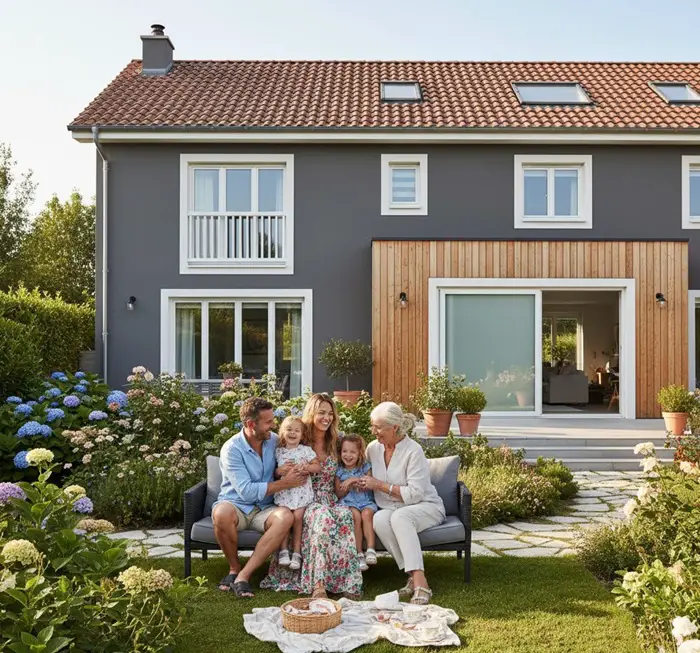
9. Farrow & Ball Pavilion Gray
Pavilion Gray sits in that elegant sweet spot between classic and contemporary.
This soft gray exterior paint color feels refined yet approachable—perfect for those who crave sophistication without stiffness.
Its warm undertone complements white trims beautifully, while its mid-tone depth ensures it doesn’t wash out in sunlight.
Whether you’re painting a heritage villa or a modern townhouse, this neutral gray for house exteriors delivers quiet confidence.
It’s the sort of shade that ages gracefully—always relevant, never loud, and perfectly photogenic in every season.
10. PPG Slate Pebble
For those who prefer a touch of earthy richness, Slate Pebble by PPG Paints is your guy.
This gray brown exterior paint color carries subtle beige undertones that soften its appearance, adding cozy warmth to your exterior.
It pairs exceptionally well with stone foundations, tan roofs, and black trims, making it ideal for transitional-style homes.
The result? A sophisticated, balanced façade that looks grounded yet welcoming.
If you’re after a color that bridges the gap between cool gray and warm taupe, Slate Pebble might just be your perfect match.
11. Sherwin-Williams Amazing Gray
The name says it all—Amazing Gray truly earns its title. This medium gray exterior house color carries a touch of warmth that makes it feel alive in every light.
Not too cool, not too beige—just right for homeowners who appreciate balance.
It pairs beautifully with off-whites that have soft yellow or cream undertones, creating a harmonious contrast that feels inviting yet refined.
As a neutral gray for house exterior, it adapts seamlessly to both contemporary and traditional designs, lending a subtle sophistication that quietly says, “I’ve got great taste,” without shouting it from the rooftop.
12. Farrow & Ball Cornforth White (Revisited)
Yes, Cornforth White makes a repeat appearance—and rightfully so. It’s one of those soft gray exterior paint colors that simply refuses to go out of fashion.
Its slightly warm, delicate tone adds elegance without looking sterile.
On cloudy days, it feels cozy and grounded; in bright light, it reads fresh and open.
The versatility of this gray brown exterior paint color lies in its ability to complement almost every architectural detail—from brickwork to modern cement textures.
If there’s a color equivalent of “smart casual,” Cornforth White is wearing it perfectly.
13. Farrow & Ball Purbeck Stone
Purbeck Stone is the color of quiet confidence—a neutral gray for house exterior that feels timeless, tactile, and beautifully British.
It’s inspired by the natural stone of Dorset’s cliffs, which gives it a warm, earthy undertone that plays nicely with both greenery and architectural whites.
During the day, it feels bright and breezy; as evening falls, it deepens into a sophisticated gray with a cozy edge.
This gray brown exterior paint color brings a natural elegance to cottages and contemporary homes alike, offering warmth without weight and charm without effort.
14. Benjamin Moore Shoreline
Shoreline is the coastal gray that never tries too hard. It’s soft, airy, and infused with just a whisper of warmth—like a sea breeze trapped in a paint can.
As a soft gray exterior paint color, it balances modern coolness with lived-in comfort, making it ideal for homes that crave calm sophistication.
This shade pairs beautifully with gemstone tones like cobalt blue and emerald green, creating a fresh yet grounded contrast.
If your goal is a medium gray exterior house color that feels both contemporary and timeless, Shoreline is your smooth sailing pick.
15. Glidden Flagstone Grey
Sturdy, dependable, and endlessly adaptable—Flagstone Grey is the workhorse of exterior grays.
It’s a classic medium gray exterior house color with a slightly deeper richness that adds gravitas without gloom.
This hue complements every texture—wood, stone, or metal—and performs well under strong sunlight or shade.
It’s ideal for homeowners who love a solid, sophisticated neutral gray for house exterior that doesn’t demand constant attention.
Paired with crisp white trims or matte black accents, Flagstone Grey creates that magazine-worthy curb appeal every homeowner secretly craves.
16. Olympic Swirling Smoke
A poetic name for a poetic gray—Swirling Smoke carries faint orange undertones that add warmth and dimension.
This subtle play of hues makes it a perfect gray brown exterior paint color for homes that want character without loudness.
It feels relaxed yet refined, ideal for modern bungalows or suburban retreats. When paired with darker browns or beige trims, it evokes that “autumn afternoon” feeling year-round.
As one of the more underrated soft gray exterior paint colors, Swirling Smoke gives your exterior a sense of movement—like a wisp of sophistication floating across your façade.
17. Benjamin Moore Gray Owl
Meet Gray Owl, the ever-versatile crowd favorite from Benjamin Moore.
This soft gray exterior paint color leans warm but maintains a crisp neutrality that makes it a dream for homeowners who can’t decide between warm and cool tones.
Under natural sunlight, it glows with a gentle brightness; under shade, it feels cozy and enveloping. It’s especially stunning on exteriors accented with white trim or natural wood elements.
As a neutral gray for house exterior, Gray Owl brings harmony, calm, and timeless beauty—a perfect closing note for your color shortlist.

What Kind of Gray Paints Do You Use When Painting the Exteriors?
There are a variety of gray paints that can be used when painting the exterior of a house. The type of paint that is best to use will depend on the material of the house, the climate, and the desired appearance.
For example, gray latex paint is a good choice for houses in warmer climates because it dries quickly and resists fading. However, it is not as durable as oil-based paint, so it may not be the best choice for a house in a colder climate.
If you are looking for paint that will give your house a unique look, consider using oil-based paint that is meant for exteriors. This type of paint can add depth and interest to the exterior of your home.
It is also very durable, so it will be able to withstand the elements in a colder climate.
No matter what type of gray paint you choose, make sure to read the labels carefully before purchasing.
Some paints are better suited for certain types of houses than others. Choosing the right paint will ensure that your house looks its best and lasts for a long.
Tips for Choosing the Right Gray Colour Combinations for Exterior Walls
Choosing the right grey isn’t just about picking a shade that looks good on a color card—it’s about how it behaves in real light and real life.
Start by observing how sunlight hits your home throughout the day; cooler greys often appear bluish in bright light, while warmer tones gain richness at dusk.
Consider your roof color, landscaping, and even the surrounding architecture—greys can clash or complement depending on context.
Texture also matters: matte finishes soften modern facades, while satin sheens highlight architectural details. And finally, test samples on exterior walls before committing.
Grey can shift dramatically with shadows, weather, and light, so what looks “perfect” indoors may tell a very different story once it steps outside.
Here are a few further tips to keep in mind when selecting the best exterior paint and color for homes:
1- Selection of colors that match well
When you talk about exterior wall paint colors, it is important to go with one or a maximum of two options, as more colors on the house’s exterior make it look cluttered.
If you think a single shade will give your house a monotonous look, choose different shades of that color.
The combination will provide an appealing look to your house.
Another great idea for the best exterior paint color is to never choose dark shades of black.
These colors are dust absorbent and force you to repaint your exterior walls more often.
However, it is suggested that you should use pale colors of dark shade and mix them with light shades.
As dark colors provide a sense of dignity to your house, you can use them to highlight the major features of the house.
2- Attractive as well as durable
The exterior is the first thing that any passer-by sees.
Hence it is essential to choose the exterior paint color which is appealing to the eye.
Bright colors bring in an additional appeal to your house at first glance.
Brighter shades are a go-to exterior paint option as they are eye-catching and grasp immediate attention, even from a distance.
The quality and kind of exterior home paint color used also determines the durability of the paint color regardless of the shade chosen.
High gloss paints aren’t suitable for exterior wall paints even though they have the longest durability.
You should choose satin or eggshell for a perfect exterior wall paint finish.
They are simpler to clean and more durable. These finishes also add to your exterior paint color ideas.
3- Effect of nature and painting season
No matter what color or finish you choose, it will only look good if it fits in with the surroundings.
People living by the sea or in hilly areas should focus more on choosing the paint color for their exterior walls according to the materials like brick or stone used.
The paint should match well with the mood and weather of their surroundings and backdrop.
Cool colors are recommended for houses located in hilly areas as it goes well with the weather and greenery surrounding the home.
Also, remember that exterior wall paints are more durable if they are painted in a particular season.
Regardless of the type, color, and quality of the exterior wall paint used, it also needs a minimum temperature to be painted well.
Exterior walls are painted perfectly in summers as there is a sufficient temperature for the paint to dry appropriately.
While painting in winters and the rainy season will make you re-do it.
4- Go for a theme according to exterior furnishings
If you know what you want on your exterior wall, you can achieve it easily.
Working around your exterior with a pre-decided theme in your mind will help you in choosing amazing color ideas.
It will also give your entire house a wonderful look.
Just like your interior, you can enhance your exterior paint colors also with furnishings.
So, if you have furniture or any other furnishings, make sure that the exterior wall paints you choose look more charming.
This also means that the wood or metal furniture used should gel in well with the color of the exterior wall paint.
Along with furnishings, also check the color of your window trims and roof before picking the paint/stain for exteriors.
5- Oil-based vs. latex for exteriors
When selecting the exterior wall paint and colors, there are two major kinds of exterior paints to select from latex and oil-based paints.
Remember, oil-based paints are long-lasting and water-resistant compared to latex.
They also offer a shiny hard finish with a bold color appearance and are majorly used by expert painters.
You should use oil-based paint if the surface you are going to paint has previously been painted with oil-based paint.
While painting, it is important to stir oil-based paint from time to time as the oil in these kinds of paints may separate quickly.
If you are using oil-based paint, then use a roller or brush precisely designed for oil-based paint.
Latex exterior paints have seen a lot of improvements and some can be as long-lasting as oil paints. They are also simpler to work with and clean.
Make sure you choose an exterior latex for use on the exterior of your house, and never use the same latex on your inside walls.
What is the Process of Painting an Exterior House? How Long Does it Usually Take?
The process of painting an exterior house with gray colors usually begins with preparing the surface.
This may involve power washing, sanding, and/or priming the siding or trim.
One of the most common mistakes people make when painting an exterior house is not properly preparing the surface before painting.
This can result in the paint not adhering properly and/or peeling off soon after it is applied.
Once the surface is properly prepared, the painter will select the right gray paint colors and apply them to the surface.
Once you are finished, do not forget to inspect the finished product.
How long does it take to paint the exterior of a house will depend on the size of the house, the type of paint used, and the number of painters working on the job.
A small house could be painted on weekends, while a large house could take a few weeks.
If you’re using high-quality paint, it may also take longer to apply than a lower-quality product.
In general, though, you can expect the painting of an average-sized house to take between one and two weeks.
Final Thoughts
The advantage of utilizing grey to paint the outside of your home is that it will not reveal dirt and filth as easily as white or another light-colored property.
And, if you’re not ready to go full grey on your home, you may test it out on other portions of the house first to get a sense of how it feels.
Warm grey, for example, can be used as a siding color.
As a result, you’ll have a plethora of alternatives for complementing trim and other areas like doors and windows as accent colors.
Remember to use bright colors for things you want to stick out, like your front door.
Hope you found this piece of content helpful.
And I wish you all the best as you are now finally ready to experiment with warmer shades of grays for your house exteriors.
Share the post "17 Warmest Gray Colors for Home Exterior"

Douglas Becker (aka Painter Doug) has over twenty years of experience as a painter in Adkins, Texas. At present, he resides in Florida with his family.
From painting multi-storeyed houses, condos, and apartments to large commercial buildings and small offices, he had served various customers in areas not only in Adkins but also in Southwest Florida, Sarasota, Naples, and many more. To know more about him check here.

